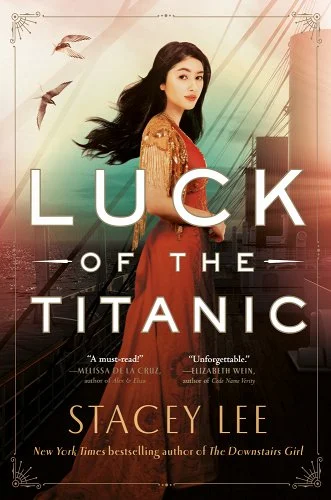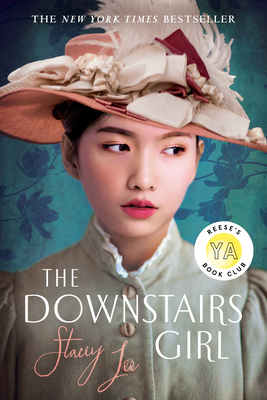interview by Kristi Wright
Stacey Lee and I became friends many years ago at a local SCBWI conference. Since then Stacey has become one of the shining stars of Historical YA and a fierce advocate for giving a voice to the voiceless. In her latest novel, Luck of the Titanic, she weaves a fictional tale that honors the untold story of the Chinese passengers on that ill-fated voyage. It’s been a privilege to watch Stacey reach new heights as an author, from winning prestigious awards to becoming a Reese’s Book Club pick (The Downstairs Girl).
KidLitCraft: In other interviews, you’ve talked about being inspired to write Luck of the Titanic by a Washington Post article about the eight Chinese men on the Titanic. How did you go from that spark to Valora Luck’s story?
Stacey Lee: I knew the eight Chinese men would be an essential part of the story, but I did want a female protagonist because I’m always wanting to write books about strong girls. I also love writing sibling relationships, so the sister/brother dynamic felt most natural for this story. In the course of researching the Titanic passengers, I learned that one of the first class passengers was connected to the Ringling Brothers Circus, which sparked the idea that Valora and her brother Jamie might be family acrobats.
KLC: Your main characters are always courageous under incredibly trying circumstances. They are also driven by a deep love, whether for a parent, a friend, or a sibling. What process do you use to create your unforgettable characters?
SL: I’m one of those people who will cry if you’re crying or laugh if you’re laughing. Empathy has its drawbacks, especially when reading the news, but on the plus side, I think it helps me create deeper characters. The secret for creating unforgettable characters is to give them impossible choices. The story of the Titanic has built-in impossible choices—who do you save? Who do you leave behind? The more impossible the choice, the more we care, the more a character becomes unforgettable.
KLC: I’m always impressed by your deft use of character memories to enrich your character development. Do you have any techniques for building and honing these?
SL: I do love using memories; I think it’s such a useful tool to define a character and make them unique. Occasionally they’re inspired by stories I hear from others, or from articles I read, but mostly I just take an idea and play with it like you’d mush around putty with your fingers.
KLC: Your characters often look at the world with irony, which adds humor to their interior thoughts. Does that come naturally to you? Do you have any craft tips for your fellow writers?
SL: I consider that a huge compliment because I don’t think of myself as a ‘witty’ type and have learned never to tell a joke because I inevitably forget the punchline. But I do love to laugh a lot, and for me, finding irony in a situation is a good life skill that I encourage everyone to practice.
Craft tip: I think the funny comes from observing things that people overlook, but still relate to. For example, in one of Sue Grafton’s mysteries, someone blows their nose, and the main character wonders, why do people always check their tissues to see what their honk has netted? The humor comes from Sue Gratfton’s ability to hone in on details, coupled with the ability to use words like ‘netted.’
KLC: In your other historical novels, you were adept at offering your readers a variety of exciting settings to enhance their sensory experience. In Luck of the Titanic, you were constrained (for the most part) by one overarching setting. How did you tackle the ship to still provide a variety of experiences for your readers?
SL: Great question! I treated Titanic as its own city and made sure each setting evoked unique emotions, the boiler room with the awe-inspiring boiler ‘dragons,’ the poop deck with its cat walk which Valora fantasizes about using as a stage, even the boat deck with its tarp-covered lifeboats, which could hide late-night rendez-vous. Giving each ‘place’ an emotion I think helped prevent setting-fatigue.
KLC: With five books under your belt how has your writing process evolved?
Writing books has become both harder and easier. Harder because I feel like I’ve told all my jokes, so to speak, and I have to keep coming up with new material. Harder because there are more expectations from readers. Easier because I know what my weaknesses are (like pacing) so I try to spot them earlier in the writing process before they become a problem (doesn’t always work!). Easier because I’ve let go the idea of organizing my notebooks and decided a little chaos is okay.
KLC: What can fans of Stacey Lee look forward to moving forward?
SL: My middle grade debut WINSTON CHU VERSUS THE WHIMSIES coming next spring (2023) with Rick Riordan Presents, a reimagining of a classic Chinese folktale, where Winston saves the owner of a curiosities shop from a robbery only to be gifted a broomstick and a dustpan for his trouble—items that turn out to be more a curse than a blessing when they sweep away important stuff, like his baby sister. And of course, I’m working on another young adult historical, this one a mystery set in 1930’s Los Angeles Chinatown, called THREE FIERCE CLOUDS that I hope to share more about soon.
For more great craft discussions, check out our interviews with Rita Williams-Garcia and Lisa Moore Ramée.
Kristi Wright (co-editor) writes picture books and middle grade novels. Her goal as a writer is to give children a sense of wonder, a hopefulness about humanity, and a belief in their future. She is represented by Kurestin Armada at Root Literary. She is an active volunteer for SCBWI and a 12 X 12 member. Find her at www.kristiwrightauthor.com and on Twitter @KristiWrite.




COMMENTs:
0